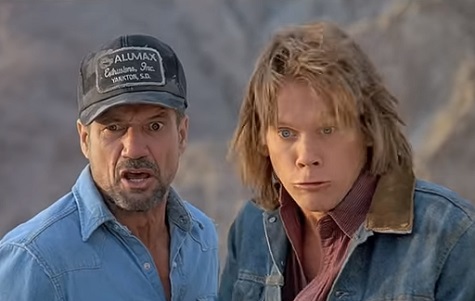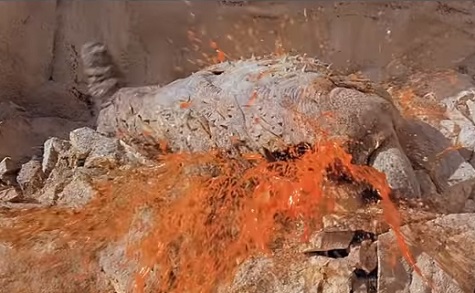Tremors was released to theaters in January 1990, where it made a profit but largely underperformed. A ragtag group of oddballs defending a small California town under siege by giant sandworms was apparently hard to market. But it found an audience on home video, becoming one of the year’s bigger rentals, and at one point — 1991? 1992? — it aired on network television, where it was taped (aside from the first five minutes) and watched over and over again by a young Miller.
Tremors is one of those movies that people may not know of, but those who do know it almost certainly like it — it’s not obscure enough to be truly cult, but it’s loved by its fans. Why? Because it’s a perfect B-movie, small in scale but executed with care and enthusiasm and joy. Vincent Canby, who has been kicked around so much for his wrong opinions that one more time won’t hurt, said the movie “was clearly more fun to make than it is for us to watch” and that’s dumber than a sack of rocks — the fun of making it is apparent onscreen and adds to the viewer’s enjoyment. But more importantly, that fun is backed by craft and intelligence. Smart creators make decisions that someone looking to make a creature feature, or any movie where ambition runs up against financing, would do well to emulate. In the past, The Solute has enumerated 10 things action filmmakers need to remember, but come on, we’re in B-movie territory — our budget only allows for five.

1. Setting Is Story
Tremors takes place in the tiny town of Perfection, Nevada. It was filmed in an entirely constructed set just over the border in California, but the geography — a few buildings for a town, residences increasingly spaced out in a flat expanse bordered by a huge canyon on one side and the Sierra Nevadas on the other — is real. (Well, mostly — the canyon is a phenomenal matte painting.) Our leads, longtime buddies and handymen Val and Earl (Kevin Bacon and Fred Ward), spend the first act trying to leave the area to seek their fortunes elsewhere and keep running into macabre situations on their way out of town where yet another neighbor has disappeared or died under mysterious circumstances. And of course, the one road out of town — which has the phone lines — is quickly blocked by a suspicious landslide, part of the weird seismographic behavior that is baffling visiting scientist Rhonda (Finn Carter).
Val and Earl’s ultimately futile quest doubles as a way to show us the lay of the land. The team of director Ron Underwood and screenwriters Brent Maddock and S.S. Wilson consistently and effortlessly layer characters’ actions with larger expository needs like this, and here Underwood makes sure to compare the impermanence of human structures — double wides, flimsy shacks, the truck that Val and Earl live out of — with the unforgiving landscape of the plain, which not only offers little shelter but almost no relief from its flatness. A few boulders and a reservoir channel are the only other landmarks besides the buildings. So many movies seem like they could take place anywhere, and Tremors could theoretically be set in a suburb or city, but the filmmakers here understand Perfection’s wasteland is the perfect trap. The difficulty of filming in a specific place is more than paid off by how that place defines everything going forward. This is a hard place to live in under normal circumstances, and a rough one when contact with the outside world is eliminated. And then the giant sandworms arrive, and every inch of ground under the characters’ feet becomes a possible point of attack. This is where the story takes place, and a story is what actions characters take and why they take them. Those actions can be defined by all sorts of emotional nonsense, but “trying to survive the place we’re in{ is clean and clear.
2. Action Is Character
Whenever Val and Earl have a disagreement — and they have many — they settle it in a time-honored fashion: through rock/paper/scissors. This is another clever move by our writers, as it establishes our heroes as at least a little juvenile, but also as people who do things instead of wasting too much time arguing. It’s an action that leads to further action, and if actions lead to contradiction, that is an honest expression of character. Who among us always acts rightly? But how we act is an exhibition of ourselves.
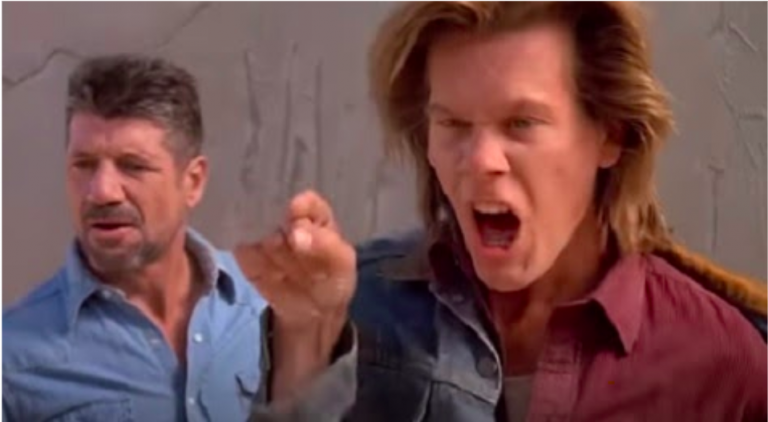
Early in the movie, when Val and Earl are preparing to leave town, they’re stopped by single mom and pottery artist Nancy (Charlotte Stewart), who asks them to stay — she’ll pay for them to build a new kiln as well as the ancillary beer expenses. Cut to: Val and Earl speeding away, whooping it up, not just ready to enjoy freedom but savoring the spice of rejecting an honest deal. It’s not nice but it’s fair. But later on, when Val and Earl have been forced back into town and see Nancy’s daughter Mindy is out pogoing on the street, causing vibrations that will soon make her worm food, Val runs out immediately, grabbing Mindy without considering the cost to himself. This, too, is who he is. And while the other townsfolk don’t necessarily share Val’s altruism, they have a similar desire for action — there are no wet blankets undermining the entire damn premise of the movie here. If the people of Perfection are caricatured, they’re sketched in motion, whether through attempted escape or attack with guns blazing.
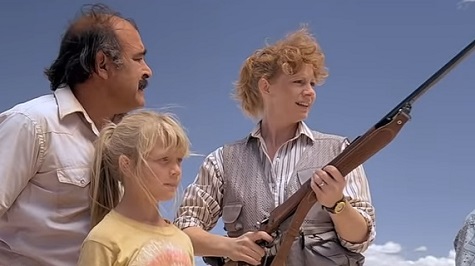
3. Restraint Is Clever, but Excess Is Awesome
In its first half, Tremors uses the horror tactic of showing little and letting the viewer’s imagination do the rest to great effect. People meet their ends in clearly terrible ways, but mostly offscreen (one shot in particular, of a car’s headlights shining uselessly to the stars as the vehicle itself and its screaming passenger are dragged beneath the ground, is haunting poetry), leaving creepy remains for our heroes to find and puzzle over. Even when the movie reveals its monsters, it does so halfway, when Val and Earl discover a three-foot-long snake thing and assume it’s one of many causing trouble. Anyone who has seen the movie’s poster or trailer knows otherwise, but it’s still a thrill when the characters, who think they know what they’re in for, wind up face to gruesome face with a creature the size of a school bus, who uses those smaller snakes as a combination of tongue and tentacles to grab its prey. Surprise!
But Underwood, Maddock and Wilson understand something crucial here — once you have giant sandworm monsters in the picture, you can no longer fuck around. The mystery has been solved and the unsettling horror needs to be replaced with a more direct kind. When the worms — because of course there are four of them — attack, they do so with mounds of dirt marking their trail, and they knock over buildings and tear up floors to get what they want. The tension is not whether they will attack, it’s whether their victims will get away — or fight back. In one of the movie’s best setpieces, Heather and Burt (Reba McEntire and Michael Gross), introduced as slightly cranky survivalists, face off with a worm that crashes through their basement compound and into their gun room. The couple blast away with rifle, shotgun, elephant gun and even a flare gun, finally filling the worm full of enough holes to put it down. “Broke into the wrong goddamn rec room, didn’t you, you BASTARD!” Burt yells in triumph. The movie has fully shifted gears to where it needs to go.
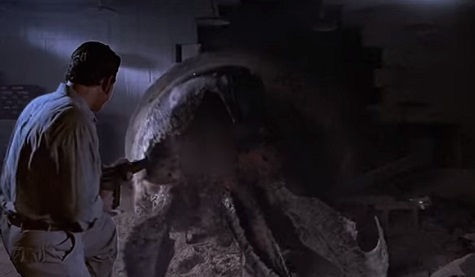
4. Editing Is Also an Effect
A real fake thing is almost always better than a fake real thing. Which is to say that a physical effect that moves with some jank or lacks in visual polish still has tangible weight, the reality of gravity, as opposed to an effect that looks flawless but is not moving or lit in the same way as the things it theoretically shares the screen with. Amalgamated Dynamics handled the effects for Tremors. A few years later, they would do creature work for Alien: Resurrection and Starship Troopers and recently handled the, uh, animal effects for Sorry To Bother You. They are pretty goddamn good! And their worms here are outstanding, bulky bodies with weird three-jawed mouths housing those snake tongues. They move with hunger but also a crude intelligence, able to retreat and even strategize if necessary. They also turn into streaming red piles of guts real good. But they are also filmed to maximize their effectiveness. Watch Val and Earl’s first encounter with one, starting about two minutes or so into the clip:
What a reveal! The ground bulging up under them, Val’s “Must be a million of em!” immediately slamming to that huge bastard heaving out of the earth. Cut to Val and Earl, staring in shock. And notice how we have not seen our boys and the worm in the same frame. We won’t for the entire sequence, which is edited by O. Nicholas Brown and mixes a solid variety of shots — the worm above and moving through the ground, the boys from in front and from close behind, at foot level — before it ends with a smash at the aqueduct, where the sequence still cuts back and forth between the dying beast and Val taunting it*. At one point, Underwood switches back to implied horror (and cost-savings!) mode, showing the boys running by a fence as the fenceposts are knocked over by the worm traveling underneath them. The confrontation, from initial attack to resolution, is created entirely by juxtaposition of separate shots pieced together into a relentless adrenaline rush.
The movie does make use of a full-sized monster and places it alongside humans (most spectacularly in that basement invasion) but also uses miniatures to great effect, with outstanding work on that front from 4-Ward Productions, brought on by producer Gale Ann Hurd after working with her on Aliens and The Abyss. In a great behind-the-scenes feature, the brothers running the company talk about the difficulties of matching the lighting of their sets to the “real” ones shot with natural light, and their hard work shows in the flawless cuts between scenes. Even when the characters are not acting opposite their opposition within the scene, they’re not faking interaction with a presence to be named later, and what they are battling is shown in the same light as they are. There is a crucial distinction between violence and action that the makers of Tremors understand intuitively — pure violence is often best served by bluntness, the impact shown without over-styling or eliding cuts, but despite the trend toward “one-shot” marathons, editing is crucial to good action. Editing sets the rhythm of the interactions of bodies in motion as well as potentially allowing those bodies to be of different scale while creating a coherent work. It’s not so much sculpting in time as stitching so smoothly that the seams become an unacknowledged part of the whole.
5. Backstory Is Unnecessary
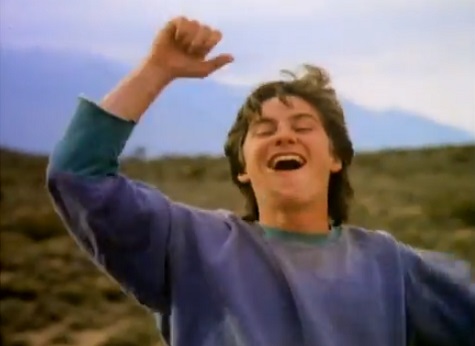
One of the side characters of Tremors is a kid of 15 or so named Melvin. Melvin is the movie’s comic relief, he exists to antagonize the other characters with annoying practical jokes and fakeouts before Burt repays the favor with a lie of his own toward the end. On the most recent rewatch, it occurred to Mrs. Miller and myself — what the hell is Melvin doing here? He’s not part of Nancy and Mindy’s family and doesn’t seem to have any real adult supervision. Melvin is just there, and we eventually settled on the theory that he was so obnoxious his real family purposefully left him behind while he took a bathroom break or something during a road trip.
Melvin’s past is obscure, but so is that of Nancy and Mindy, for that matter. Or that of Walter, the guy who owns the general store, or Miguel, the dude who is just hanging around there all the time, or even Earl and Val. They’re out there in Perfection and that is all that’s important. And that goes double for those wormy Graboids, as Walter names them. Once they’re discovered there’s a brief discussion of where they came from — outer space? A time older than the dinosaurs? — which is quickly brushed aside. (I’ve never gotten into the ongoing Tremors franchise in part because it seems like these kinds of questions would wind up being answered at some point.) As a movie, Tremors doesn’t have time for that kind of theorizing and knows it’s irrelevant anyway. It doesn’t matter where the Graboids came from, what matters is where they’re headed. Which is through the inhabitants of a town and the town itself, wreaking havoc before blowing up after eating explosives and blowing through a canyon wall to a splattery death. As a personal example, it might not signify anything, but to the filmmaker the example is solid: Don’t look back, go hard, and leave a giant pile of guts when you’re through.
*And speaking of editing — after the MPAA rated Tremors R for language, the producers decided to cut down most of the language, which is why Fred Ward says things like “motherhumper.” But in those days a PG-13 flick was still allowed one F-bomb, and Bacon delivers a magnificent “FUUUUUUUUUUUUUUUUUUUUCK YOU!” to the vanquished monster after it runs into the reservoir. Another good guideline: If you only get one opportunity, in profanity or in other cases, make it count.

